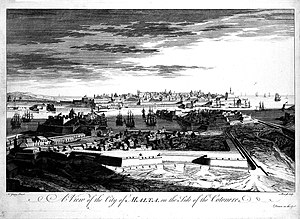Santa Margherita Lines
| Santa Margherita Lines | |
|---|---|
| Is-Swar ta' Santa Margerita | |
| Cospicua, Malta | |

The Santa Margherita Lines in their original form in c.1725
|
|

Map of the Santa Margherita Lines and the Cottonera Lines. The Santa Margherita Lines are the inner line of fortifications.
|
|
| Coordinates | 35°52′44.4″N 14°31′23.8″E / 35.879000°N 14.523278°E |
| Type | Line of fortifications |
| Site information | |
| Owner | Government of Malta |
| Condition | Partially intact |
| Site history | |
| Built | 1638–1645, 1715–1736 |
| Built by | Order of Saint John |
| Materials | Limestone |
| Battles/wars | Siege of Malta (1798–1800) |
The Santa Margherita Lines (Maltese: Is-Swar ta' Santa Margerita), also known as the Firenzuola Lines (Maltese: Is-Swar ta' Firenzuola), are a line of fortifications in Cospicua, Malta. They were built in the 17th and 18th centuries to protect the land front defences of the cities of Birgu and Senglea. A second line of fortifications, known as the Cottonera Lines, was later built around the Santa Margherita Lines, while the city of Cospicua was founded in the 18th century within the Santa Margherita and Cottonera Lines.
The Santa Margherita Lines have been on Malta's tentative list of UNESCO World Heritage Sites since 1998, as part of the Knights' Fortifications around the Harbours of Malta.
The lines, also known as Santa Margherita Enceinte, were built to the designs of the Jesuit Cardinal Fra Vincenzo Maculano da Firenzuola.
The foundation stone of the Santa Margherita Lines was laid on 30 December 1638 by Grand Master Giovanni Paolo Lascaris. The lines were designed by Vincenzo Maculano da Firenzuola, and were meant to protect the land fronts of Birgu and Senglea, and also to prevent a flanking attack on the capital Valletta. The lines were built on Santa Margherita Hill, known colloquially as il-Mandra, possibly on the ruins of an ancient Greek temple or an earlier castle. The hill is featured in the account of the Great Siege of 1565 by arquebusier Francesco Balbi di Corregio, who mentioned that a belvedere existed on it.
...
Wikipedia
